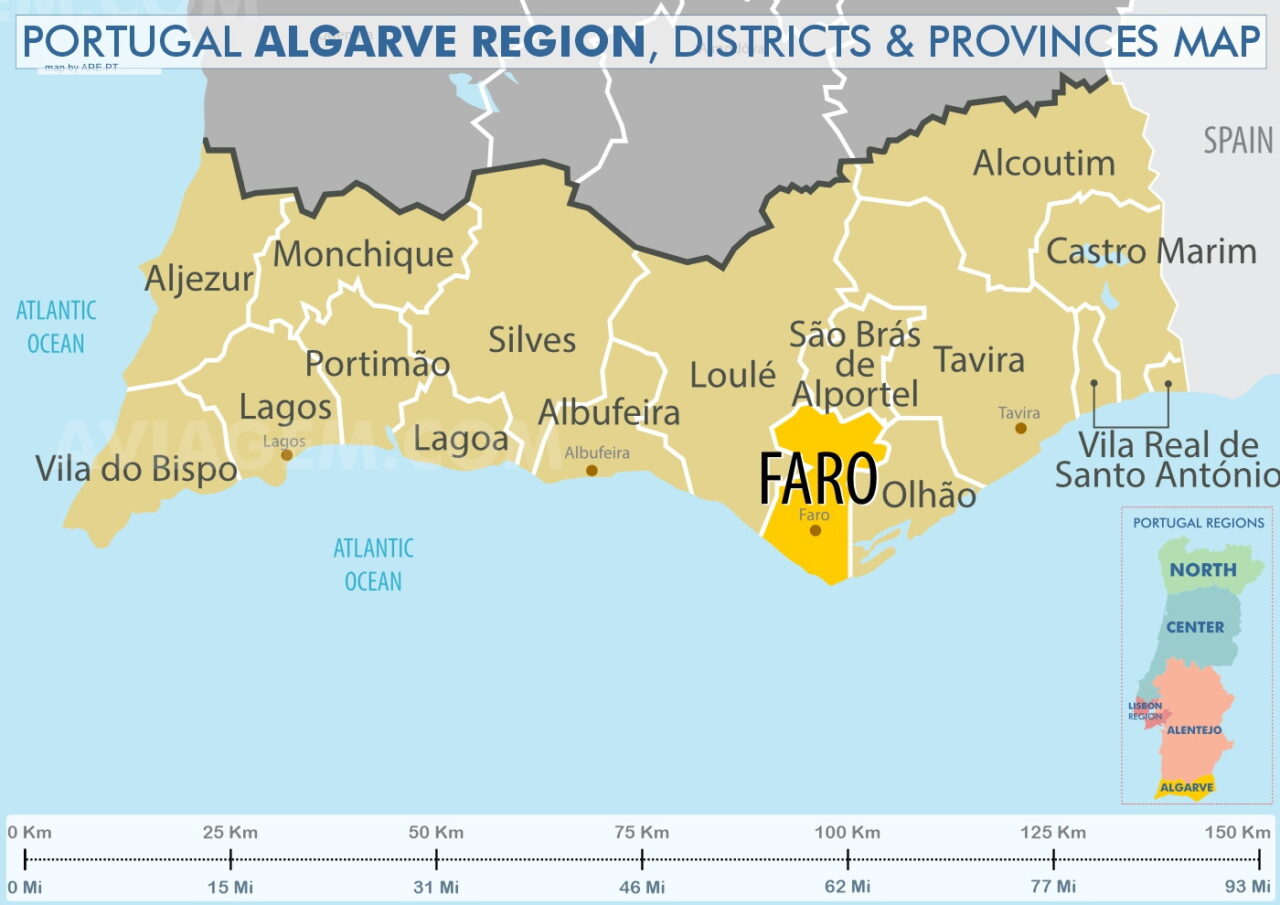
Faro, Algarve region capital city
Faro is the administrative capital of the Algarve, presenting itself as an ancient city, full of history, tradition and culture. It has a vast natural and built heritage, with emphasis on the beaches and landscapes of the Ria Formosa. The arrival to the south of Portugal can be done by the Faro Airport, a structure that serves the city and the rest of the south of Portugal.
In Faro we have the opportunity to walk through streets with a more commercial flair, such as Rua de Santo António, known as the street of Faro’s shops, and immerse ourselves in history, strolling through the historic center to get to know the old city walled, with a mandatory stop next to the imposing Arco da Vila, the historic and legendary Arco do Repouso and the Arab Gate, which constitutes the only horseshoe arch in the Algarve that is located in its place of origin.
In this old area, within the walls reinforced by the two albarrãs towers, we find the Igreja de Santa Maria (or Sé de Faro), in a square ornamented by the Monument of Bishop Francisco Gomes de Avelar, a prominent regional figure for his contribution to the development of the locality.
The Sé de Faro stands out for its Gothic, Baroque and Mannerist architecture, dating back to the 13th century and bringing eighteenth and nineteenth-century features in the valuable details of its interior, with emphasis on the details in gilded wood, the chapel panels, the tiles and reliquaries. Of equal interest, in front of the statue of D. Afonso III, we find the Convent of Nossa Senhora da Assunção, a Manueline-style church that stands out for its Renaissance portico and baroque dome, as well as for the gargoyles that decorate the upper floor. This convent currently houses the Museu Municipal de Faro, within which we find a collection focused on the history of the region.
Faro also offers us other places of interest, such as the Manuel Bivar wooded garden, corresponding to the city center, and where various cultural events take place. The culture in the city is also manifested in the exhibitions of the Centro Ciência Viva do Algarve, focusing mainly on science and the Ria Formosa ecosystem. Visiting this space, it is worthwhile to proceed to Marina de Faro (or Doca de Faro), the place where land and sea come together, allowing pleasure boats to dock. Here, we find the Museu Marítimo Almirante Ramalho Ortigão, with three rooms dedicated to fishing, instruments and utensils, as well as the Ginásio Clube Naval, which includes a sailing and recreational nautical school. At Cais das Portas do Mar (Cais da Porta Nova) we can embark on sea voyages through the Ria Formosa, even to access some of the most beautiful places in the region, such as the Ilha Deserta with its Barreta beach. In the area bordering the city we can enjoy the Parque Ribeirinho de Faro, divided into three green areas, where we find a pedestrian zone, a place where the culture and tradition of the Algarve are perpetuated through the fishermen’s houses facing the river.
Faro’s cultural, religious and historical heritage
Immersion in the traditional tradition of Faro implies visiting the Mercado Municipal de Faro, located next to the Cathedral and whose white building stands out for its central square tower. This market allows the purchase of innumerable fresh local products, introducing us to the customs of the village. Religiosity is one of the fundamental points of this tradition, which extends the invitation to visit the local churches and chapels. In Largo do Carmo we find the Igreja do Carmo of the 18th century, a Baroque style temple where the interior decorations in tile and gilded wood stand out, as well as the attached Capela dos Ossos, erected in the 19th century . The Igreja da Misericórdia, a Manueline and 17th century church; the Igreja de São Pedro, with a simple façade and an interior where the Capela do Santíssimo and its rich Baroque altarpiece stand out; the Chapel of Santo António do Alto, a 16th century chapel that mixes Gothic, Manueline, Baroque and Rococo architectural features; the Church of Nossa Senhora do Pé da Cruz, whose façade is a reflection of the architecture of different times and with an interior decoration from the 17th century; and the Convent of Santo António dos Capuchos, built in the 17th century, with a simple facade and ornamentation, which served for some years as a museum of archeology. Faro is a place of tradition and many football fans, where we find the São Luís Stadium, located near the church with the same name; the remains of the Roman passage through the region, in the Roman Ruins of Milreu and the Roman Bridge in Estói and the Palácio de Estói, a complex of high historical value and dating from the 17th century, where an inn currently operates.
Natural heritage of Faro
The Ria Formosa Natural Park, whose headquarters are located in Quinta de Marim, is considered one of the 7 Natural Wonders of Portugal, corresponds to one of the most important wetlands in the country, allowing the encounter with a great diversity of habitats conducive to the development of an equally diverse fauna and flora, with an integrated environment in the part of the Eastern Algarve between the area of Ancão and Manta Rota, consisting of a harmonious lagoon system with a connection between land and ocean. To get to know the entrance to Ria Formosa, between Quinta do Lago and Faro Island, we can walk the Ludo Trail, a 7-kilometer trail where we have contact with the lagoons, marshes and animal life in its natural habitat. Taking advantage of the footbridge that crosses the Ria Formosa, we arrive at Ilha de Faro, one of the beaches of the Natural Park and the first of the barrier islands that separate the estuary from the ocean. Ilha da Armona and Ilha da Culatra are also prominent places for bird watching. Here there are villages with small communities of local inhabitants, which are evident by their fishing traditions, by the sandy beaches, clear waters, by the offer of bathing and catering infrastructures. Next to Ilha da Culatra there is a small town with the name of Hangares, which got its name due to the existence of infrastructure left from the time of the 2nd world war. Of the barrier islands, the Ilha do Farol is another of the natural riches of Faro, owing its name to the Lighthouse of Cabo de Santa Maria visible from long miles, and presenting itself as a place of great natural beauty. The small Ilha do Coco, Ilha das Alturas and islet of the Koran deserve mention, where we can see shellfish harvesters throughout the year, the primary activity of many of the inhabitants of Olhão and the islands of Culatra, Armona, Farol and Hangares. Traveling through the populated region of Ria Formosa we can see small boats that serve the local population, allowing fishing in the estuary.


